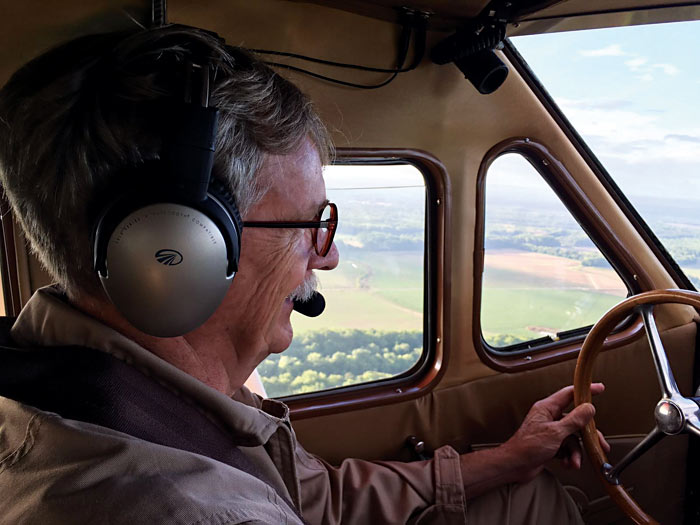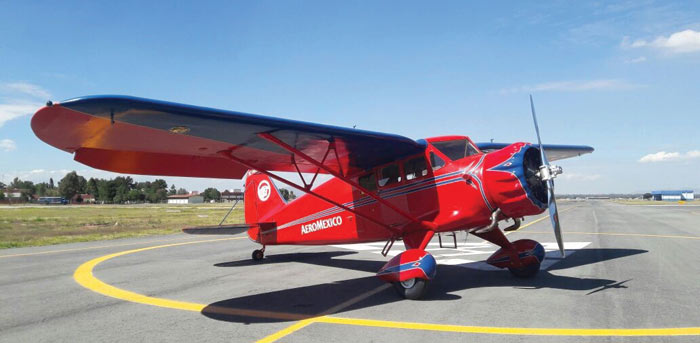Our Stories: Retired Pilot Discovers He Owns a Piece of Airline History
By John Perkinson, Senior Staff Writer
Several years ago, lifelong general aviation enthusiast Capt. Bob Schneberger (US Airways, Ret.) purchased a vintage Stinson Reliant to enjoy in his retirement—not realizing that the aircraft (NC14163) had a “past.”
Schneberger, who retired from airline flying in 2005, was volunteering at the EAA AirVenture Oshkosh fly-in and convention in the summer of 2013 when he marshaled a 1934 Stinson Reliant SR-5A into a parking space. “I had never seen a Stinson before. I didn’t know anything about them,” recalled Schneberger. The former Eastern, Trump Shuttle, and US Airways pilot immediately fell in love with the airplane, describing it as “absolutely gorgeous.”
Not letting the Wisconsin airfield’s grass grow under his feet, Schneberger quickly introduced himself to the Stinson owner, Keith Swalheim, and expressed an interest in purchasing the airplane. The two struck a deal, and Schneberger became the next in a long line of the airplane’s titleholders.
Schneberger noted that the aircraft was in “museum condition” and that the previous owner had gone to great lengths to make it operable. An article in the May/June 2014 issue of Vintage Airplane described Swalheim’s incredible efforts to make the SR-5A a true showpiece.
Depression-era transport
A product of the Stinson Aircraft Division of the Aviation Manufacturing Corporation, the Stinson Reliant is a single-engine, high-wing monoplane built between 1933 and 1941. With a wingspan of nearly 42 feet, the original four- to five-seat SR-5A cruised at a speed of 115 miles per hour and was able to cover more than 450 miles a leg. The aircraft was originally powered by a 245-horsepower Lycoming R-680-6 radial piston engine, but this model was refurbished with a 300-horsepower R-680-E3B.
Back at his home in McLean, Va., Schneberger received an interesting e-mail. A man named Ray Sinatra said that he had heard about Schneberger’s recent purchase and wondered if the Stinson was flyable. Sinatra explained that he was helping to produce a documentary about Aeroméxico’s first flight in celebration of the carrier’s 80th anniversary taking place in 2014 and needed a Stinson Reliant for the part. Sinatra asked Schneberger if he’d be willing to fly the airplane to Mexico City, but Schneberger declined.
During the exchange, Schneberger divulged that according to the aircraft’s paperwork, one of the previous owners, Antonio Díaz Lombardo, had been a resident of Mexico City. Sinatra then asked for the airplane’s tail number, knowing that Lombardo was the founder of Aeroméxico. The two soon determined that Schneberger’s Stinson was the same aircraft used to fly Aeroméxico’s first flight. “I knew at that moment that Aeroméxico would want the airplane back,” he said.
Efforts to make the documentary eventually fell through, but Schneberger felt compelled to contact Aeroméxico to notify the company of the discovery. The airline later responded, indicating that representatives would fly to Virginia to see the airplane to confirm its provenance. They made the trip during the summer of 2015, setting in motion the Stinson’s return to its original owner.
In February 2016, Schneberger flew to Mexico City to share with the company the various documents he had acquired with the airplane’s purchase and to discuss dates for its return. He learned that the Stinson is a very important symbol in the airline’s culture as an oil painting of it hangs in Aeroméxico’s corporate offices.
Historic journey
On May 26, 2016, Schneberger set out from the Manassas Regional Airport in Manassas, Va., accompanied by Aeroméxico Capt. Alejandro Garfias, a B-737 pilot and Asociación Sindical de Pilotos Aviadores member. The two immediately hit it off. Schneberger noted, “Garfias is a really nice guy and a good pilot.”
On the first leg of their journey and throughout the trip, Garfias took many photos. On approach to Lynchburg Regional Airport, Schneberger was flying. Garfias rolled down his window (you can do that in an SR-5A) to get a better view with his iPhone camera.
“The next thing I know, he’s looking at me with empty hands,” said Schneberger, adding that a gust of wind deposited the smartphone somewhere in the surrounding countryside. “We laughed and laughed for days about that,” he said.
The two made uneventful stops in Columbia, S.C.; Macon, Ga.; Dauphin, Ala.; and Gulfport, Miss. Approaching Lake Pontchartrain, the pilots smelled what seemed to be an electrical fire. They declared an emergency and quickly landed at a small, nearby airfield. The odor turned out to be from a piece of felt, used as a sound insulator, that had lodged itself against the airplane’s exhaust pipe.

At the controls, Schneberger is enroute to Middle Georgia Regional Airport.
Schneberger and Garfias continued on to Lafayette, La., and then to Galveston, Corpus Christi, and Brownsville in Texas. They crossed the border and immediately landed in Matamoros, Mexico, where Schneberger signed the paperwork for the Stinson Reliant’s return to Aeroméxico. From there, they continued on to Tampico and Santa Lucia, just north of Mexico City.
However, the final trip to Mexico City International Airport didn’t occur until five months later. Because only commercial airplanes are authorized to land at the airport, Aeroméxico worked with Mexico’s aviation regulatory authority over the next several months to verify that the airplane’s commercial certificate and paperwork were valid.
On Feb. 5, 2017, the SR-5A finally touched down in the same city it first departed from 82 years ago. Three days later, nearly 1,000 Aeroméxico employees and guests crowded into an airline hangar for a special ceremony to honor the “return of the legend.” Prominently placed large video screens told the story of the airline’s very first flight on Sept. 14, 1934. Soon after, the hangar’s doors were opened and Schneberger and Garfias taxied the Stinson, repainted in its original livery, in front of the exuberant crowd.
A documentary, Stinson: El Regreso de Una Leyenda (YouTube), by Spanish director and screenwriter Miguel Catalán tracked the historic aircraft’s journey home. During the production, Schneberger acknowledged that sitting at the controls of the Stinson, he felt a special connection to both its original pilot and the aircraft’s legacy as a part of airline history. “There’s a lot of emotion flying such a beautiful airplane,” he said.
The 1934 Stinson Reliant SR-5A is currently on display at the Santa Lucía Air Force Base Museum, north of Mexico City.
Maiden Voyage

Aeroméxico began operations as Aeronaves de México on Sept. 15, 1934, when the airline operated its first flight using a Stinson Reliant SR-5A (NC14163) to transport four passengers from Mexico City to Acapulco. Piloting the aircraft was Capt. Julio Zinser, a graduate of the Aviation Military School. The aircraft departed from Balbuena airfield and one hour and 40 minutes later landed at Los Hornos, a local spa by the beach. The flight’s passengers each paid 30 pesos for the trip. The aircraft would complete 45 roundtrip flights for the airline before being sold two years later.

